http://www.lymeaid.net/Lyme-Facts.htm
THINGS TO KNOW ABOUT BORRELIA
Borrelia b. (Bb) is unique among pathogenic bacteria. Firstly; and most importantly with regards to its ability to evade therapeutic agents and our immune system, it has one of the most advanced and complex DNA structures of any bacteria known. This allows it to assess its surrounding chemistry and alter its cell membrane in an effort to ensure its survival.
Secondly; it has the ability to move through tissue. Being a spirochete, an organism more or less in the shape of a spiral, it can 'bore' deeply into our cells where it can hide form our immune system. This is also one of the reasons the organism can have such a devastating affect on the tissues of the heart, the nervous system and the joints. Once there it has another nasty little trick. If the situation looks dire for the bacteria it can form a cyst and remain encapsulated for 2-4 months then revert back to an active bacteria.
Thirdly; while most human bacterial pathogens utilize the element iron in its cell, Bb uses magnesium. This can result in a tissue deficiency of magnesium. Depending on the cells of our body that become deficient the resulting symptoms could be muscle twitches and spasms, irregular heart rhythm, high blood pressure or any one of a number of neurological or digestive symptoms. It is more than interesting that magnesium is a necessary ion in hundreds of reactions in the human body and that up to 50% of the American population is deficient in this essential nutrient. You may have found that some practitioners may recommend limiting ones intake of magnesium in an effort to "starve out the Bb". This is not a good idea and I, along with many others, recommend an increased intake of magnesium to avoid the above mentioned symptoms. The only caution here is if there is a complete atrioventricular block magnesium should be used with extreme care. See a physician if you have heart palpitations.
Fourth; the cell membrane of Bb is, no surprise, quite a bit different than other bacteria. Its membrane composition is more like that of the cells of mammals in that it contains phosphatidylcholine (PC). The other major component of its membrane is phosphatidylglycerol (PG). And, it doesn't appear to contain any phosphatidylserine (PS) in the cell membrane. Bb does not synthesize its PC via the more common pathway other cells utilize though it does appear to be able to manufacture its own. It is important to understand that all cells need to increase their cell membranes in order to divide and therefore reproduce. This leaves me considering that Bb's tendency to associate itself with our nervous system is possibly in part because our nerves are loaded with PC and what a nice source to tap into. It has also been suggested that having a cell membrane high in PC, and therefore "looking" like one of our own cells, may aid Bb in its effort to avoid our immune system.
Cinco; Borrelia b. produces and releases toxins into our bloodstream or directly into tissue. One toxin that has thus far been identified (Bbtox1) is considered to be a neurotoxin. It is not uncommon for pathogens to produce and release chemicals which negatively impact humans. The organisms associated with tick bites, however, are particularly notorious for producing neurotoxins. I am sure more Bb neurotoxins will be discovered as this is the only way that makes physiologic sense out of the myriad of seemingly random and migrating neurological symptoms associated with Lyme disease. Richie Shoemaker, MD, in his research regarding the neurological symptoms associated with estuary syndrome, discovered some interesting facts about pathogenic organisms and neurotoxins.
Sixth; Tryptophan is an essential amino acid. In our bodies it is necessary for the formation of serotonin and melatonin. It is also an important nutrient to our immune system, as is melatonin. The Lyme spirochete alters tryptophan metabolism which may result in a decrease serum tryptophan level. A decrease in tryptophan availability results in a lowered immune response to Bb and may lower the levels of serotonin and melatonin in our tissues.
Some of this information, and more, is in Stephen Harrod Buhner's book Healing Lyme. This is a very good book and highly recommended. Most of the information here is from research journal articles which are referenced in the bibliography to this site....
